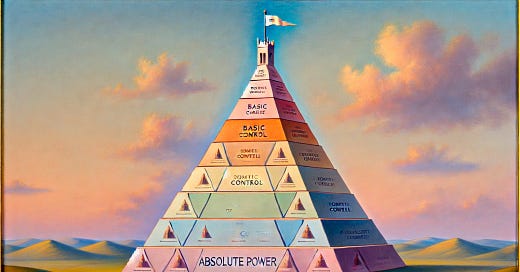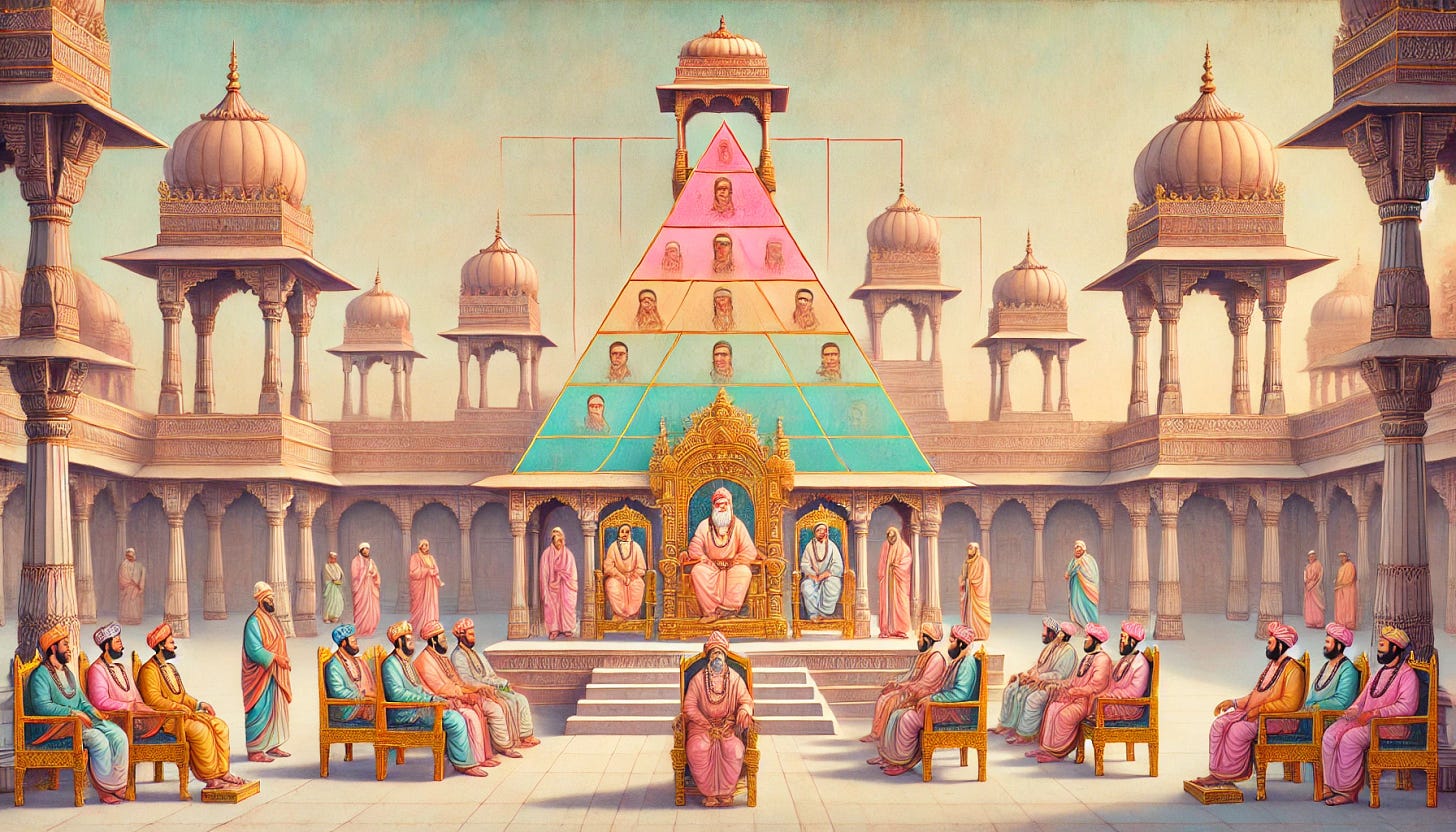Maslow's Political Pyramid: From Influence to Absolute Power
However, as ancient Hindu scriptures suggest, such power inevitably sows the seeds of its own downfall, leading to a cyclical rather than linear progression.
Maslow’s Hierarchy of Needs in the Political Arena
Maslow's hierarchy of needs is a well-known psychological theory that describes human motivation through a pyramid, which begins with basic physiological needs and ascends through safety, love and belonging, esteem, and finally culminates in self-actualisation. Given by the American psychologist Abraham Maslow in 1943, it became a part of the standard curriculum in business management and organisational behaviour courses, and mainstream lectures on leadership and motivation. Each level represents a different set of needs, with the fulfilment of lower levels providing the foundation for the higher levels.
Similarly, we can conceptualise a hierarchy of political power, where the apex represents absolute, undisputed control—akin to the reign of a dictator or sovereign king. However, as history and ancient Hindu scriptures suggest, such power inevitably sows the seeds of its own downfall, leading to a cyclical rather than linear progression. This cyclical nature reflects the transient and ever-changing dynamics of political power.
The Hierarchy of Political Power: A Cyclical Journey
Level 1: Basic Control and Influence
At the base of the pyramid lies the foundation of political power: basic control and influence. This stage involves acquiring the fundamental resources and support necessary to exert influence. Political actors at this level are focused on gaining followers, resources, and initial legitimacy.
Key Elements:
Grassroots support
Initial funding and resources
Establishing credibility and legitimacy
Level 2: Consolidation of Power
Once a political figure has established basic control, the next step is consolidation. This involves securing alliances, eliminating opposition, and creating a stable base from which to exert influence. At this stage, the focus is on strengthening and expanding one's power base.
Key Elements:
Forming strategic alliances
Neutralising or eliminating rivals
Establishing a loyal inner circle
Level 3: Expansion and Dominance
With power consolidated, the next level involves expansion and dominance. Here, the political actor seeks to extend their influence over a broader area or population, often through conquest, annexation, or extensive reforms. The aim is to dominate and control larger spheres of influence.
Key Elements:
Expanding territorial or ideological control
Implementing wide-reaching policies
Establishing dominance over opponents
Level 4: Institutionalisation of Power
The penultimate level of the hierarchy is the institutionalisation of power. At this stage, the leader or ruling group embeds their control within the structures of society, making their power seem natural and unchallengeable. This often involves creating laws, norms, and institutions that perpetuate their dominance.
Key Elements:
Embedding power within legal and social institutions
Cultivating a cult of personality or ideological supremacy
Ensuring succession and continuity of power
Level 5: Absolute Power
At the apex of the pyramid is absolute power, where the leader or group holds undisputed control. This stage represents the zenith of political power, with no significant opposition and total dominance over all aspects of society.
Key Elements:
Totalitarian control
Unquestioned authority
Perception of invincibility
The Seeds of Destruction
However, as ancient Hindu scriptures suggest, this pinnacle of power is inherently unstable. Absolute power often leads to arrogance, complacency, and detachment from the populace. These factors, combined with inevitable internal and external pressures, lay the groundwork for downfall.
Key Factors Leading to Decline:
Arrogance and detachment from reality
Internal power struggles
Popular discontent and rebellion
External threats and challenges
The Rhetoric and Optics of Political Power
Often, the rhetoric or messaging at various stages of political power is diametrically opposed. An absolute ruler would claim to be working for the welfare of the poor, excluded, and downtrodden, while a fledgling politician might project a larger-than-life image, essentially "fake it till you make it." At intermediate stages, the adage "behave like a king and the kingdom shall follow" often applies. Therefore, when analysing the political landscape, form, optics, and messaging should not be taken at face value. Instead, the core and substratum need to be considered to understand and appreciate the various perspectives and stages of Maslow's pyramid in the political domain. Often, the oath of office to "preserve, protect and defend" is, in reality, more about securing power than upholding the constitution.
The Disruption of the Pyramid
When the undisputed leader at the pinnacle of power—especially in a seemingly democratic scenario—chooses their own heir or successor based on personal likes, whims, and fancies, it can disrupt the pyramid and lead to inherent instability. Leaders of the second rungs may resent this decision, leading to internal conflict and power struggles. Some may fight and struggle for their own position, while others may curry favour with the heir-apparent, creating significant stresses within the power structure. Transitions are always difficult; if the reigning monarch takes too long to abdicate, the next generation may become senile, as seen with historical figures like Aurangzeb and Queen Elizabeth II. In Saudi Arabia, Mohammed bin Salman (MBS) was handed over significant power while the King is still on the throne, showcasing a different approach to succession. However, these external and internal disruptions do not belie the underlying inexorable logic of Maslow's pyramid, reflecting the cyclical nature of power dynamics.
Ensuring Smooth Transitions
To ensure smooth transitions and maintain stability within the hierarchy of political power, it is crucial to establish clear and transparent succession plans. Leaders should prioritise merit-based selection over personal preferences to avoid internal strife. Engaging in open dialogue with key stakeholders and fostering a culture of inclusivity can mitigate the risks associated with transitions. However, premature discussions or even naive and innocent comments, whether in private or public, can trigger fratricidal wars of succession. Therefore, such discussions must be deftly timed and handled with utmost care. By recognising and addressing potential disruptions early on, the integrity of the political power pyramid can be preserved, facilitating a more seamless transition and reducing the likelihood of instability.
The Cycle of Power
Just as everything in nature follows a cyclical pattern, so too does political power. The collapse of absolute power typically returns the system to its initial state, where new actors begin the struggle for control, starting the cycle anew. This cyclical nature underscores the impermanence and fluidity of political power.
In summary, the hierarchy of political power, from basic control to absolute dominance, reflects a cyclical journey rather than a linear progression. Absolute power, while seemingly invincible, invariably contains the seeds of its own destruction, leading to a perpetual cycle of rise and fall. This understanding not only aligns with historical observations but also resonates with the wisdom of ancient Hindu philosophy, which recognises the eternal and cyclical nature of all things.







Excellent analysis. Could be Machiavelli or Chanakya as they both are in the same vein of thought. Thanks